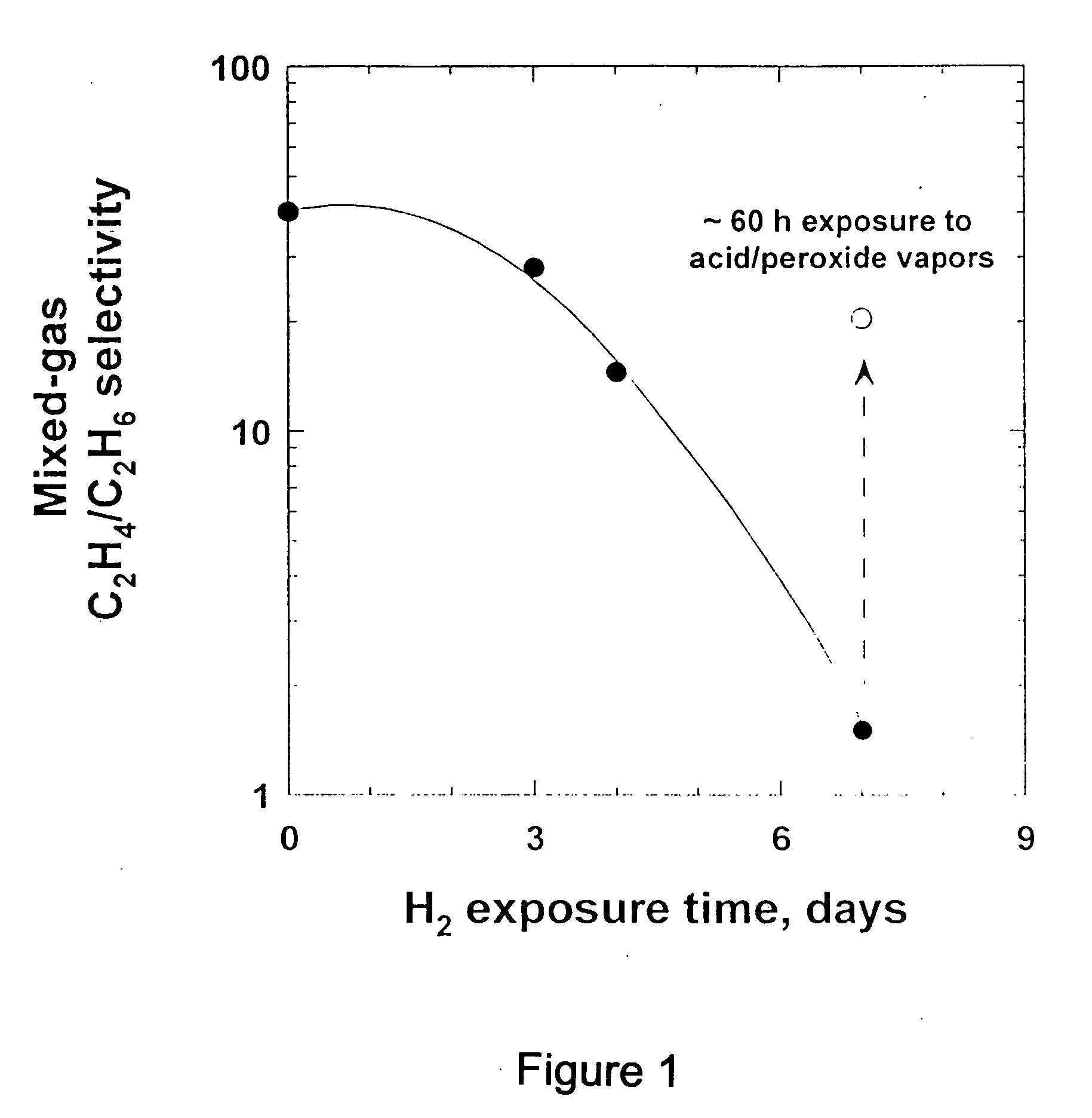Process for regenerating facilitated-transport membranes
a technology of facilitated transport and membrane, applied in the field of facilitated transport membrane, can solve the problems of unstable and low flux of transport membrane, inability to keep carrier solution within the membrane, undegraded for any length of time, etc., and achieve the effect of prolonging the useful life of the membran
- Summary
- Abstract
- Description
- Claims
- Application Information
AI Technical Summary
Benefits of technology
Problems solved by technology
Method used
Image
Examples
example 1
Membrane Making
[0114] An asymmetric microporous support substrate was prepared by casting a polyvinylidene fluoride (PVDF) solution onto a non-woven fabric support. A solution containing 8 wt % silver tetrafluoroborate and 2% PEBAX® 2533 in ethanol was prepared. The solution was coated onto the support using a continuous dip-coating process. After evaporation of the water, the membranes were dried completely in an oven at 70° C. and the membranes were coated with a second layer of the PEBAX solution. The membranes were then coated with a protective layer of 0.5% Teflon AF2400. The resulting solid polymer solution membranes had a selective layer with a silver salt content of 80 wt % and a thickness of about 3 μm.
[0115] Samples of membrane were cut into 13 cm2 stamps and mounted in a permeation test-cell apparatus. The membranes were tested with pure ethylene and pure ethane at a feed pressure of 50 psig, a permeate pressure of 0 psig and a feed temperature of 23° C. Volumetric gas...
example 2
Typical Mixed Gas Properties of New Silver Membrane
[0116] Membranes prepared as in Example 1 were tested with the test-cell apparatus of Example 1 with a gas mixture of 50 vol % ethylene and 50 vol % ethane. The feed pressure was 50 psig, the permeate pressure was 0 psig and the feed temperature was 23° C. The membrane was tested for 30 minutes at a 1% stage-cut. The membrane fluxes were measured and the selectivities were calculated. The results are shown in Table 1.
TABLE 1Mixed gas permeanceMembrane(gpu)SelectivitysampleC2H4C2H6C2H4 / C2H61250.66372220.65333290.7837
[0117] As can be seen, the mixed gas ethane permeance is much higher than the pure gas measurement, and as a result, the mixed gas selectivity for ethylene / ethane is very much lower than the pure gas selectivity. This result is attributable to the membrane swelling caused by high olefin content in the membrane.
example 3
Properties of Aged Membranes
[0118] Membranes prepared as in Example 1 were stored in an open bag at ambient conditions for 10 months. During this time, light and chemical reducing agents present in the polymer or in the atmosphere reduced silver ions to silver metal causing the membrane to turn black and lose selectivity. A sample of aged membrane was tested as in Example 2, the fluxes were measured and the selectivities calculated. The results are shown in Table 2.
TABLE 2Mixed gas permeanceMembrane(gpu)SelectivitysampleC2H4C2H6C2H4 / C2H61166.22.52133.73.7
[0119] As Table 2 shows, the performance of the membranes deteriorated severely during storage. Ethylene permeance was much lower than the original value shown in Table 1 and ethane permeance increased. As a result, the selectivity was very low. These results demonstrate that silver-containing membranes suffer a marked loss of selectivity when exposed to reducing agents.
PUM
| Property | Measurement | Unit |
|---|---|---|
| Transport properties | aaaaa | aaaaa |
| Exposure limit | aaaaa | aaaaa |
| Selectivity | aaaaa | aaaaa |
Abstract
Description
Claims
Application Information
 Login to View More
Login to View More - R&D
- Intellectual Property
- Life Sciences
- Materials
- Tech Scout
- Unparalleled Data Quality
- Higher Quality Content
- 60% Fewer Hallucinations
Browse by: Latest US Patents, China's latest patents, Technical Efficacy Thesaurus, Application Domain, Technology Topic, Popular Technical Reports.
© 2025 PatSnap. All rights reserved.Legal|Privacy policy|Modern Slavery Act Transparency Statement|Sitemap|About US| Contact US: help@patsnap.com



